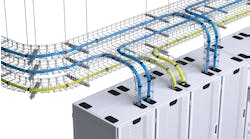DCIM Software: What’s Driving User Satisfaction in 2018?
In this week’s Voices of the Industry, Herman Chan, President of Sunbird Software, discusses the current state of Data Center Infrastructure Management (DCIM) software adoption and how second-generation DCIM is providing value for its growing group of end users.
Herman Chan, President of Sunbird Software
It’s 2018, and more organizations than ever are leveraging DCIM software for smarter, more efficient data center operations and management. A glance at customer reviews for data center infrastructure management tools shows consistently high ratings among end users, even as they highlight the cons and recommendations for improving their data center software products.
New data also supports this increase in adoption and user satisfaction. According to Uptime Institute’s most recent annual survey of global data center professionals, 54 percent of respondents have purchased some sort of commercial DCIM software, and 75 percent of those respondents consider their deployments successful.
This positive attitude toward DCIM software seems a far cry from the reaction of early adopters. Many early users were disappointed to find that the wide range of initial DCIM software solutions did not deliver as promised.
Why the sudden shift? Due to modernizing data center environments and advancements in the data center software itself, today’s DCIM software is a significant improvement over the data center tools of even just a few years back.
Why Second-Generation DCIM Software for Modern Data Centers?
As discussed in a previous article, second-generation DCIM refers to a new class of emerging data center software that addresses many of the pain points experienced with legacy DCIM. It is designed to help modern data center managers make smarter, more data-driven operational decisions.
Data centers are modernizing, evolving into complex, hybrid environments. Additionally, intelligent rack PDUs with outlet metering, other smart devices, and instrumentation have resulted in increasingly massive amounts of data being generated in data centers, with some of our customers pulling in one billion data points a day. As a result, modern data centers are too distributed and difficult to manage with legacy tools like spreadsheets and basic floor map diagrams.
That’s where this new breed of DCIM software can make a difference. Second-generation DCIM combines enhanced versions of the monitoring and operations features available in legacy DCIM tools with new functionality and usability enhancements designed to tackle all the challenges of these modern data center environments.
How Is Second-Generation DCIM Software Driving Value for Users?
Second-generation DCIM software may seem like the preferred simply because it has newer features and functionality. However, this is only part of its appeal. In fact, what sets second-generation DCIM software apart is its improved user experience. Consider just a few of the ways end users benefit from the switch to second-generation DCIM:
- Faster deployment times. For many legacy DCIM tools, by the time the software was actually deployed, the initial enthusiasm has long worn off. Second-generation DCIM software can be deployed in half the time with significantly fewer resources and effort, so end users can start benefitting from their investment immediately.
- Modern, easy-to-use, web-based GUI. Unlike traditional DCIM tools that required a steep learning curve, second-generation DCIM uses an intuitive GUI that decreases the time spent training for faster onboarding. Second-generation DCIM is also web-based, versus client-based, so updates are faster, and the database can be accessed by any user – anytime, anywhere.
- Zero-configuration analytics, dashboards, and reports. To address the large volume and variety of data in modern data center environments, some organizations are turning to manual analysis via spreadsheets or third-party data analysis tools. In contrast, second-generation DCIM software includes pre-built, zero-configuration dashboards and interactive reports that work out of the box, without additional configuration by end users. As a result, users can get the information they need to share with management or other teams and make data-driven decisions about capacity, power and environmental monitoring, and other key use cases – without the need for a separate data analysis tool.
- Integration with third-party databases. Using a CMDB or BMS to help manage your data center systems is one of the most common use cases for data center professionals. With legacy DCIM tools, however, integration with third-party systems was limited or nonexistent, forcing users to duplicate data across multiple systems, wasting time and potentially introducing manual human error. Second-generation DCIM software saves time and simplifies data sharing and connections across disparate databases through automatic integration with existing systems.
- Multi-vendor support. Most legacy DCIM tools only supported a narrow range of vendors. For modern data center managers whose environments contain many devices across multiple manufacturers, this limitation could create unnecessary expenses and compatibility issues when purchasing new hardware. Second-generation DCIM can manage all these different devices so enterprises aren’t locked in to a specific vendor. Instead, it works with what organizations have in their data centers today.
Due to modernizing data center environments and advancements in the data center software itself, today’s DCIM software is a significant improvement over the data center tools of even just a few years back.
A better user experience on its own won’t necessarily guarantee increased user adoption. However, when combined with features designed for modern data centers, it can help data center teams become more efficient and productive overall. As a result, data centers can respond to IT resource demand with speed and agility. In other words, second-generation DCIM allows you to operate your enterprise data center like cloud provider.
Bringing It All Together
For end users, second-generation DCIM software bridges gaps across their most common use cases. It helps them complete their daily tasks more easily, respond more rapidly to changing conditions in their data center environments, and make requests to management with the data to back up their arguments. These benefits and more are leading to high satisfaction rates, increased usage of the software, and a strong return on investment.
The increasing adoption and satisfaction rates among DCIM software users are no passing fad. Although there is still room for improvement with modern data center tools, these trends are expected to grow as more organizations see the value of leveraging second-generation DCIM software to better manage their data centers.
Herman Chan is President of Sunbird Software.





